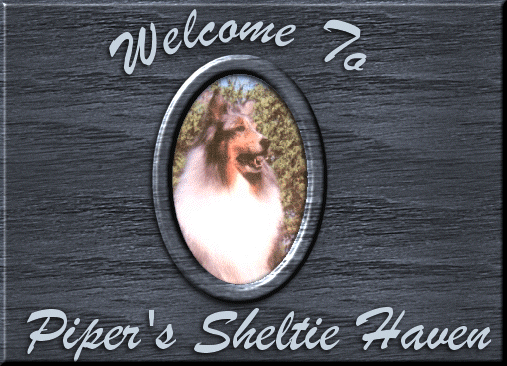

Welcome! Thank you for visiting Piper's Sheltie Haven.
I am very glad you want to know more about the charming
and very active Shetland Sheepdog.This hardy diminutive "look alike" of the much larger Collie is however, a breed quite unique to itself. I say that to help you understand that the Sheltie is NOT a miniature Collie, although it often is referred by that misnomer. They were originally known as the Shetland Collie until a dispute amongst it's enthusiaists changed the name to reflect the Sheltie's origin as well as the breed's purpose, to work sheep. That name change officially occurred in 1908 when the Shetland Sheepdog Club of Lerwick came into existance.
The Sheltie (the correct nickname for the breed), is from the Shetland Islands off the north coast of Scotland. They were used to herd the Shetland Sheep that grazed the Island's windswept coasts. The agile Sheltie was often left alone on the Island with it's own flock of sheep to watch over. Their best job was to keep the straying sheep from the cliff edges where certain death would have been their fate. Shelties were also very good at chasing those naughty Shetland Sheep out of the Islander's gardens. These jobs are the reason why Shelties bark constantly and love to chase other dogs, children and cats.
The Sheltie is on the small side most of the time. However, due to infusion of Collie lines they sometimes produce specimens a bit larger than normal. Piper is a good example of how big a "large" Sheltie can reach, standing 9 1/4" at the shoulder. He also weighs in at about 45/50 lbs., although his penchant for stealing food might be the cause for his rather chubby waist! Most often Shelties range in size from 13- 16 " with a normal weight of 14-35 lbs.,.
This highly active breed sports a beautiful full coat in colors of black, tan and white, sable and white, blue merle tan and white, blue (without tan) and white, and the rare Bi-black. This latter color is simply a black and white Sheltie. There are also other rather rare colors sreferred to as the Cryptic blue and the Bi-Blue. I need a bit more clarification on these color designations myself. If you are a Sheltie breeder don't hesitate to help me define the differences between those two colors. I would appreciate it.
The best part about the Sheltie is that they are very intelligent. Shelties learn easily and seem to enjoy showing off their routines. Consistently scoring high in obedience, agility and herding events. This is an affectionate breed too. They make good therapy dogs if socialized early in life and earnestly too. Don't hide your Sheltie away in the house and then thrust it into the lime light expecting total acceptance to strange noises. Shelties must experience all types of situations to become all they were meant to be, happy alert and charming little dogs. A shy Sheltie is a very unhappy pup. Buy your new Sheltie from a breeder that believes in socializing their dogs. It is very important.
Now it is necessary to understand that Shelties may be reserved with strangers. Do not confuse this behavior with a Sheltie that is shy. One will usually warm up to a stranger once introduced properly. A shy sheltie is scared of it's own shadow so to speak. Take notice if pups cower in the corner of their own surroundings or do they take notice of you with curious interest.
Sheltie's are not for everyone. Be sure you have researched the breed thoroughly before running out and getting the first pup you see. Do not but from a pet shop. Those pups are sure to have a plethora of problems you will find very frustrating to deal with later in life.
I hope you will enjoy reading about Piper's life with our family and his two Border Collie companions.
Piper's Page lovely maintained
and copyrighted (1998-2000) by:
The Sheltie graphics were found at: